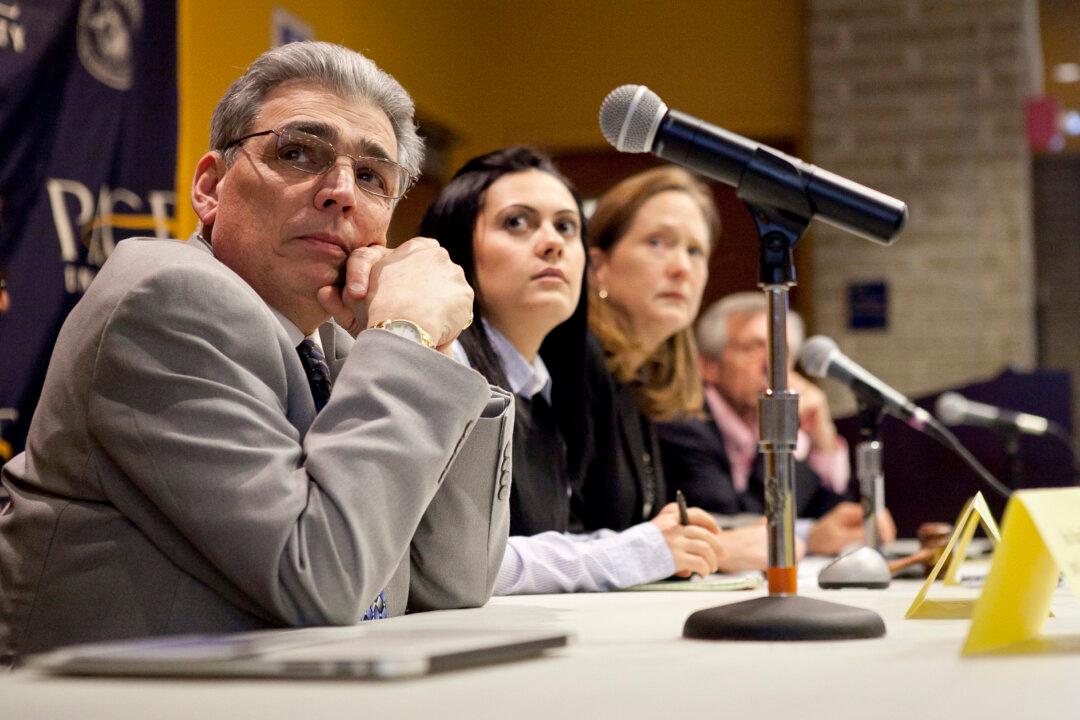NEW YORK—Standing in front of a packed room of New Yorkers, Chris Curry detailed the Texas-based developer’s vision for the South Street Seaport. Already a popular New York City tourist destination teeming with character, the developer will build modern amenities and restore the Seaport’s deteriorated pier pilings. Curry said it’s a win-win-win for the city, its residents, and the developer.
By and large, the response and input has been positive and constructive, with little to no opposition, said Curry, senior executive vice president of development for the Howard Hughes Corporation (HHC).
He said the corporation has solicited feedback in various forms from over 1,000 stakeholders, including residents, and the response has been largely constructive and supportive.
At the Jan. 13 town hall meeting and in other similar public settings, Curry has often characterized support from the city and local stakeholders as a mandate to move forward with the development.
Many in the community see the reality as otherwise.
At the town hall meeting before the local community board, an early key milestone in the city’s standard development review process, a majority of the eight organizations and 47 individuals who publicly testified expressed reservations about HHC’s plan. Some were emotional. Some were outright angry.
“The Brooklyn Bridge and the South Street Seaport vista are known around the world,” said Joel Sasinski, a 25-year resident of nearby Southbridge Towers, who said he once saw a poster in Paris advertising the destination.
Sasinski said to impose a high-rise building, which some community members have compared to a pastrami sandwich, in the middle of the famed skyline, would be akin to creating “an obscene gesture.” His comment, along with his raised middle finger, sent a wave of uproarious applause through the crowd. Others in the room echoed the idea of the tower as obscene.
“I hope the city rejects this proposal outright,” said Sasinski.
Of great concern for many is HHC’s proposal to build a high-rise tower at the water’s edge, obstructing the open view of the Brooklyn Bridge and adding an uncharacteristically tall tower to a skyline of three- and four-story historic brick buildings.
HHC maintains its series of developments will be financed by the revenue produced by the tower, which involves high-end apartment units, hotel space, and an adjacent marina. The revenue will offset the more than $125 million price tag for the work, as well as maintenance costs for the pier pilings, which support the district’s buildings.
That’s money that HHC said it will be saving the city, in both the short term, and the long term.
“It’s very important for people to understand the economic ramifications [of these plans],” Curry told the community.
The project involves restoring and moving a historic building, expanding street access, repairing and replacing badly damaged pier pilings, and demolishing the former site of the Fulton Fish Market (called the New Market Building), the site of the proposed tower.
HHC’s vision is to create a shopping, dining, and entertainment destination that caters to the 9 million tourists and visitors that flow through the area every year. According to Travel and Leisure magazine, the Seaport is the 26th most popular tourist destination in the world.
Save the Seaport
Even with the projected financial benefits for the city and increased shopping and dining amenities, objections to building the tower in a prized and singularly unique historic district have been strong.
“These are public assets, and at the moment they have been de-facto privatized by the old (mayoral) administration and the old EDC,” said Michael Kramer, a member of the community group Save Our Seaport.
Kramer and his group are also deeply worried over the future of the South Street Seaport Museum, which has a number of assets in the area, including world-renowned historic buildings, an irreplaceable treasure trove of maritime archival material, and antique ships. The museum’s main building has been closed since Superstorm Sandy and its stewardship was passed from the Museum of the City of New York to an interim board.
“We don’t want the development of the new Howard Hughes Corporation tower to be tied to the South Street Seaport Museum,” said Kramer. “We want the museum to be in control of the waterfront—we think they’re more qualified than Howard Hughes.”
Pastrami Tower
Some longtime residents and professionals with roots in the neighborhood are agitated at the prospect of a skyscraper amid nothing but low-rise brick buildings on Manhattan’s waterfront.
Others have taken to characterizing it as a pastrami sandwich on the waterfront, based on the architect’s rendering of piles of dark brown pastrami-colored floors stacked up between the odd light colored floors resembling bread.
The overarching sticking point, though, continues to be the destruction of the New Market Building to make way for the new development.
“We do have concerns about the proposed redevelopment of the New Market Building,” said Roland Lewis, president and CEO of the Metropolitan Waterfront Alliance (MWA), which represents over 700 organizations with waterway interests in New York City.
Lewis is also a board member of the New Amsterdam Market that wants to restore and use the building for a permanent public market space. Aside from the esthetic and contextual neighborhood concerns, he pointed out that the city of New York “has not built in the water for a long time.”
Robert LaValva, founder and president of the New Amsterdam Market and one of HHC’s most vocal critics, has formed a group to oppose the plan called Just Press Pause. The group wants the city to stop and rethink the plan, and use a master planning process that closely involves all levels of stakeholders, from local residents to business owners to the city.
“Our aim is not to fight against the current plan by Howard Hughes,” said LaValva at the town hall meeting. “We don’t think we should have to fight against a plan that should never have been proposed.”




